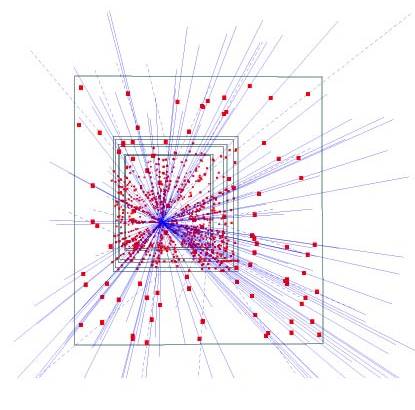The first use of large area hybrid pixel detectors in a High-Energy Physics experiment is illustrated by the picture below, showing 153 high energy particle tracks flying through a telescope of half a million pixels in the WA97 experiment back in 1995. Every red dot in this image signifies a pixel which has been hit by a charged particle and there are no pixels giving false hits.

The very first Medipix chip was produced in the 1990s when an informal collaboration of four institutes, the Medipix1 Collaboration, demonstrated the potential of the new technology to provide noise hit free single-photon counting. This used the same front-end architecture as the Omega3 chip (used in WA97) but incorporated a counter per pixel. It was quickly understood that Medipix could have great potential outside of high-energy physics. To further develop this technology and take it to new fields the Medipix2 Collaboration was born in 1999, the Medipix3 collaboration in 2005 and finally the Medipix 4 collaboration in 2016. Through the Collaborations, three generations of Medipix chips have been developed, each with improvements and new features.
The Medipix2 Collaboration gave life to the Medipix2 chip, with improved spatial resolution, and the Timepix chip which is a modified version of Medipix2 with the additional functionality of time or amplitude measurements. Out of the Medipix3 Collaboration came the Medipix3 chip and the Timepix3 chip which, as well as counting photons, can determine the energy level of each individual photon detected. The Medipix4 Collaboration aims to design pixel read-out chips that for the first time are fully prepared for Through Silicon Via (TSV) processing and may be tiled on all four sides. This will not only enable large areas to be covered seamlessly but will also permit the development of new read-out architectures by avoiding the need to send all of the data to one side of the chip for readout.
The Medipix technology is one of CERN’s most successful knowledge transfer cases. Each collaboration has triggered a significant number of commercial activities in widely differing application areas. Medical imaging, space dosimetry, education, and material analysis just to mention a few. Moreover, the industrial partners and license holders commercialising the Medipix technology range from established enterprises to start-up companies. Thus, the technology is contributing to value creation, not only in its application areas, but also through business creation.
